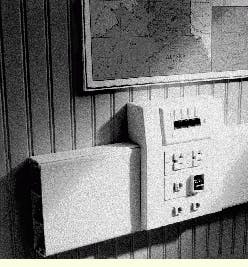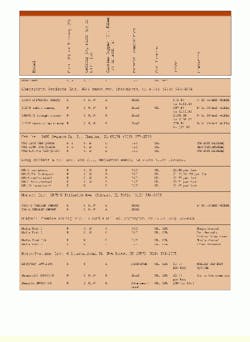Barbara E. Thompson
Sometimes known as wire management systems, raceways and ducts provide organization, security and protection for data, voice and power cabling in premises wiring systems. These metal or nonmetallic cable systems carry cables from the wiring closet to the wallplate.
Raceways vs. wireways
"Sometimes people in the field confuse raceways with wireways," says Frank Casteel, vice president at Mono-Systems Inc. (Rye Brook, NY). "Raceways are approved to mount outlet devices on them; wireways are strictly a trunking method, and their fill capacity is less than [that] for a raceway," he explains.
Power and low-voltage cable can be installed in ducts and raceways behind walls, above ceilings and underneath floors. In open-office areas, however, it is more likely that surface raceways will be used. These systems can be installed anywhere there is a wall or ceiling surface.
"For the most part, you don`t see many fixed offices," says Rich Aiello, project manager at Cablenet (Woburn, MA). "So there`s a lot of surface raceways going in. There are three ways to feed the cable--a column, a power pole or a floor-run pole (poke-through). We prewire all the cables to where the entry point is and then we have to wait to coordinate the schedule with the furniture installers. If 80% of the installation is modular furniture, you have to wait until it`s all in before you can terminate and label the cables," he says."
Another choice you have to make is which material composition you should use for your application. Surface raceways are available in steel, aluminum and plastic.
"When you`re dealing with power," says Rich Levesque, product business manager of perimeter systems at the Wiremold Co. (Bristol, CT), "The National Electrical Code requires steel in places of assembly, such as auditoriums and patient-care areas in hospitals. In addition, there are local jurisdictions: Cities such as Chicago, New York and Los Angeles don`t want plastic; they want steel."
If the installation is in a corrosive atmosphere such as a laboratory, then aluminum is a good choice but it`s soft and can dent easily. Aluminum raceways are available in many colors and designs.
Plastic raceways are used for low-voltage applications, as well as for power. "It used to be metal but a lot of it is plastic now," says Aiello. "It`s easier to mount any box to plastic because you can penetrate it more easily than metal."
One concern when installing data communications cables, especially Category 5, is noise. "Not only do you need to protect the wire mechanically," says Levesque, "you need to protect it from electrical noise. We`re doing some tests to find out if steel has better protection against power noises."
As well as considering your application, you need to determine what cables you are going to put in the raceway. If you`re installing wiring for data, voice and power, some manufacturers offer raceways with one, two or three channels. However, "there should be at least a 12-inch separation between the low-voltage and high-voltage electrical cable," advises Amy Barnes Frey, president at Alpine Communications Consultants Inc. (Broomfield, CO).
If the duct or raceway has enough capacity, you can install a replacement cable in only a few minutes. Most of the surface raceways have covers that are hinged or snap off for easy access, although Frey says, "If you need to move a cable, Murphy`s Law says it`s going to be the bottom cable in the raceway."
Coordination is the answer
From an installer`s point of view, it can sometimes seem that no raceway ever has enough space. For example, "if you`re running coaxial Type 1 cable and a couple of Category 5 cables (times eight for eight cubicles), you have a bundle of cable there," says Aiello. If the communications people are not involved in the design of the raceways, sometimes the cables do not fit. "Overall, the best plan is to coordinate with the designer and the furniture contractor prior to any raceway installation," he adds.
(For additional information, see "Ducts and raceways," May 1994, Cabling Installation &
Maintenance, page 17.)
Where Can You Use Raceways?
In the National Electrical Code 1993, a raceway is defined as Oan enclosed channel designed expressly for holding wires, cables or busbars.O The use of raceways is delineated in Articles 352, surface metal and nonmetallic raceways, 354?underfloor raceways, and 362, metal and nonmetallic wireways and Oshall comply with the applicable provisions of Article 300.O
What the NEC tells the installer, says Frank Casteel, vice president at Mono-Systems Inc. (Rye Brook, NY), Ois what you can and can?t use raceways for. For example, a raceway can be used inside a building (in dry locations) but it can?t be used in hazardous locations or elevator shafts (hoistways).O
Series 5500 raceway from the Wiremold Co. can be configured to one, two or three compartments.





